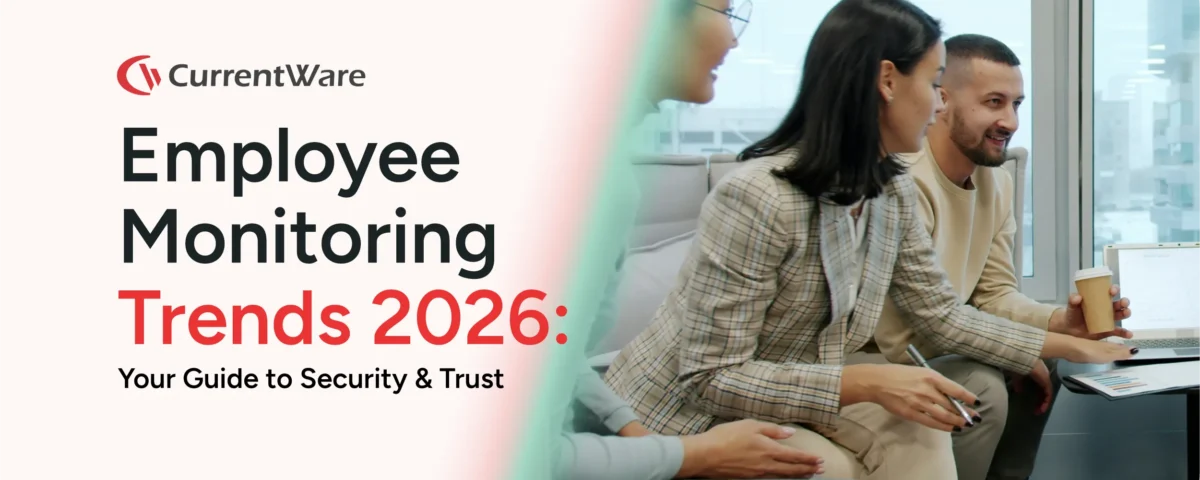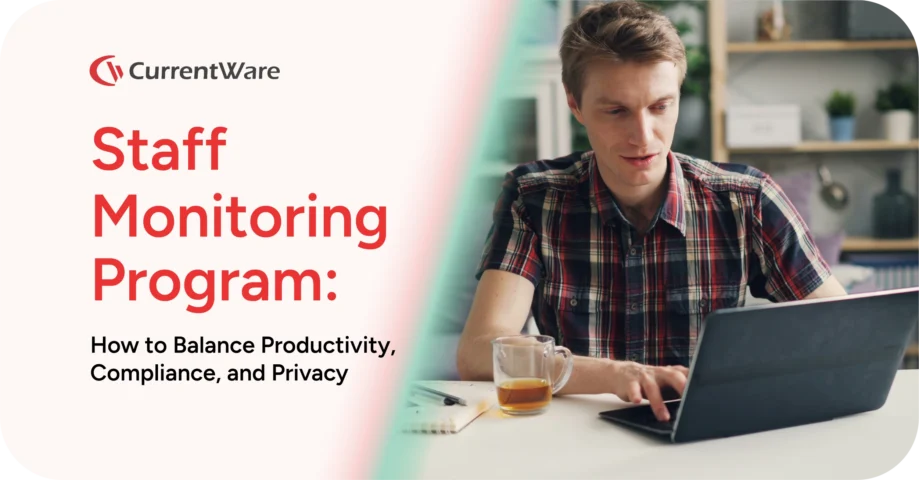The Top 6 Employee Monitoring Trends for 2025

Employee monitoring trends for 2025-2026 emphasize greater sophistication and privacy controls, with remote and hybrid work models driving adoption of advanced tools and balanced practices that prioritize transparency, accountability, and employee well-being.
Recent studies show that more than half of companies now use employee monitoring practices to oversee worker activity and maintain productivity.
1) Monitoring Solutions Are Being Adopted to Aide Hybrid Workforce Management & Return-to-Office Mandates
According to the latest Gartner digital workplace research, over 50% of knowledge workers will operate in a hybrid or fully remote capacity by 2026.
Employee monitoring software is increasingly essential as organizations blend remote and in-office work, especially in response to strong employee demand for flexibility. Owl Labs’ 2025 State of Hybrid Work Report reveals that 40% of employees would look for another job if hybrid or remote options were withdrawn, and hybrid employees now typically spend three days in the office per week.
While flexible work options boost retention, managing hybrid teams comes with unique challenges. The Owl Labs 2025 report shows that managers’ top concerns for remote employees are maintaining engagement (29%) and having reduced visibility into when and how their teams are working (27%).
With employers increasingly encouraging employees to spend more time in the office, monitoring tools that track time spent in-office versus remotely provide actionable insights to ensure employees meet in-person collaboration goals while maintaining flexibility.
These tools help organizations verify compliance with return-to-office mandates and identify trends in workspace usage, enabling managers to facilitate team meetings, encourage shared workdays, and optimize collective productivity for both remote and on-site staff.
To address these needs, companies are adopting a range of monitoring methods—including online tracking tools, time tracking tools, and other monitoring tools—to monitor employee behavior, track employee work hours, and accurately record billable hours. These solutions are used to track employee activity and performance across remote, hybrid, and in office teams, ensuring accurate payroll, billing, and operational efficiency.
Also Read: Remote Workforce Management Tips to Boost Productivity
Monitor with Confidence and Trust
See how you can build a more secure and transparent workplace
- → Real-time tracking
- → Data for compliance and cost-saving decisions
2) Employee Monitoring Software Use Will Continue to Increase
The latest employee monitoring statistics reveal a significant rise in the adoption of workplace surveillance tools, reflecting current trends and industry practices.
The adoption of workforce monitoring tools is expected to grow, with the market projected to reach USD 1,465.2 million by 2032. The trend of increasing employee monitoring software use is driven by the growing need for productivity management, compliance, and security in hybrid and remote work environments.
A study by the Massachusetts Institute of Technology (MIT) found that 80% of companies are already monitoring remote or hybrid workers. The Owl Labs survey confirms these findings, with only 19% of workers surveyed saying that their company isn’t using employee tracking software at all. Furthermore, 48% stated that their employers added or increased their use of monitoring tools. Most businesses and companies use monitoring activities to improve productivity, ensure compliance, and protect company interests, highlighting the importance of responsible and legal monitoring practices.
Also Read: Employee Monitoring Software for Productivity & Security
3) Increased Use of AI by Employee Monitoring Software Vendors
Monitoring tools collect a vast amount of data, which can be overwhelming for end-users trying to make sense of all of the reports and dashboards. To combat the complexity of interpreting data, employee monitoring software vendors are rapidly integrating artificial intelligence (AI). AI-driven analytics are increasingly used to help monitor engagement, predict burnout, and optimize workflow.
AI-powered tools process vast amounts of employee activity data faster than traditional methods, enabling real-time productivity assessments, behavioral analytics, and predictive alerts for potential issues such as disengagement or burnout. By leveraging predictive analytics and real time screen tracking, these tools deliver real time insights into employee behavior and workflow. This allows organizations to optimize workflows and enhance productivity by making timely, data-driven decisions.
CurrentWare competitors that are using AI in their monitoring software product include Teramind, CleverControl, and ActivTrak.
Also Read: How to Track AI Usage with Employee Monitoring Software
Start minimizing your software costs today.
Are you ready to start tracking software usage and start saving time and money?
4) Continued Developments in Privacy Laws & Regulations
85% of workers surveyed by Owl Labs said that employers should disclose if they are using employee monitoring tools. Approaches that prioritize employee privacy, trust, and overall well-being while meeting business objectives will ultimately be more successful than those that attempt to monitor employees in secret.
As employee monitoring becomes more prevalent in hybrid and remote work environments, privacy laws and regulations are evolving rapidly to address emerging concerns. Globally, frameworks like Europe’s GDPR, Canada’s PIPEDA, and various U.S. state laws impose stricter rules on how employers can collect, use, and retain employee data during monitoring. These regulations emphasize the principles of transparency, proportionality, and data minimization—requiring employers to clearly inform workers about monitoring practices and obtain meaningful consent where necessary.
New legal developments are focusing heavily on AI-driven monitoring, biometric data, and algorithmic decision-making, with governments scrutinizing the potential for bias and privacy violations. Employers must balance workplace security and productivity goals with employees’ rights to privacy, ensuring monitoring is reasonable, targeted, and minimally intrusive. Compliance also involves secure data management, explicit written policies, and providing employees access to their own monitoring data.
However, companies face significant legal challenges when implementing monitoring activities, especially regarding compliance with privacy laws and regulations. Ethical monitoring practices are essential to respect employee privacy and maintain trust in the workplace. Organizations must handle sensitive data responsibly, ensuring that monitoring activities do not infringe on privacy rights and that all data collected is protected against misuse or unauthorized access.
Also Read: CurrentWare Software Privacy Policy
5) Greater Emphasis on Privacy Controls
As employee monitoring technology advances, there is a growing emphasis on implementing robust privacy controls to meet regulatory requirements and minimize the invasiveness of monitoring. These controls are essential for compliance with evolving privacy laws such as GDPR, CCPA, and other global regulations, which mandate transparency, data minimization, and proportionality in monitoring practices.
Common privacy controls include:
- Limiting monitoring to specific hours
- App-provided notifications to employees
- Giving employees access to their own data
- Allowing employees to pause monitoring during breaks
- Giving administrative control over what data is collected
- Role-based access control to limit who can access employee data
Implementing strong privacy controls helps prevent data misuse and protects company data by restricting unauthorized access and monitoring how sensitive information is handled. These measures are critical for maintaining data security and help organizations ensure compliance with legal and regulatory requirements, building trust with employees while safeguarding valuable business information.
Companies must balance productivity and privacy by limiting data collection to specific purposes, retaining data only as long as necessary, and regularly reviewing monitoring strategies for fairness and effectiveness.
Also Read: CurrentWare Suite Privacy Features | Balance Monitoring & Privacy
Traditionally, employee monitoring tools were used as “bossware” for punitive measures, rather than workforce intelligence. Today’s modern employee monitoring software has evolved beyond this use case and into workforce intelligence, giving all departments of the business valuable data for a variety of purposes.
Monitoring is now recognized as a strategic business function that supports operational efficiency, security, and early detection of disengagement or burnout. Excessive surveillance can erode psychological safety, reduce innovation, and increase employee turnover, highlighting the need for balanced and transparent monitoring strategies.
Ultimately, this shift from surveillance to insights represents a more mature, human-centered approach to workforce management, balancing operational needs with respect for privacy and fostering positive workplace culture and performance.
Transparent monitoring practices foster employee trust by respecting privacy and promoting open communication. This approach has a positive impact on workplace culture, as it supports productivity, encourages healthy work habits, and helps build an engaged workforce. By focusing on clear policies and fair monitoring, organizations can create productive teams and improve employee performance, ensuring that monitoring contributes to both individual well-being and organizational success.

